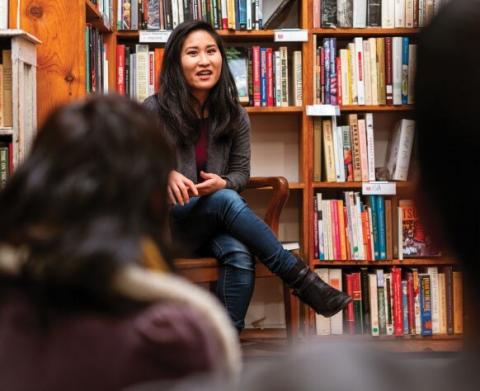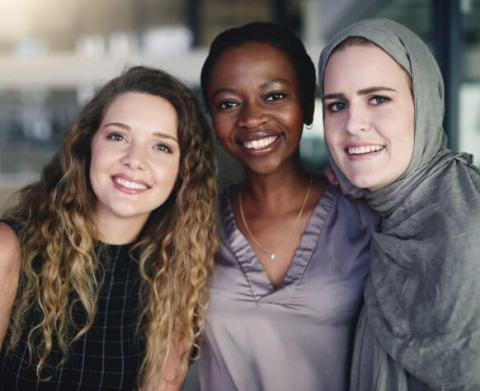
Discussion Guide
Developing And Deepening
an explicit equity lens in the work of United Ways requires intentionality. United Ways that create opportunities for leadership and staff to collectively plan, engage, assess, and improve their efforts can help build the organization’s capacity over time. Ultimately, this creates more effective and equitable strategies and interventions.
Below are discussion guides for each equity lever to help your United Way plan and reflect on your equity practices. These questions are meant to be a starting point and we encourage you to follow the conversation wherever it takes you. In contrast to the assessments for each lever, which asks you to reflect on the extent to which you have integrated a particular strategy or practice, these questions provide an opportunity to delve deeper to plan your approach and to explore in what ways you might strengthen your efforts.
You may not come to complete a resolution in a given conversation, but over time these critical questions should become a normal part of your organizational practice.
Data 🔺
Data is a powerful tool to help us measure how successfully we are applying an equity frame throughout our work. The following are key questions to ask throughout a data gathering and analysis process to ensure equity is a priority. You can further strengthen your approach by including the perspectives of community members early on and throughout the process. This conversation can be led by research and evaluation or impact staff but should engage a cross-functional group for maximum alignment and buy-in.
Key Questions To Ask When Preparing To Collect Community Data
- What problem are we trying to solve?
- Who is most impacted by this problem?
- What information already exists about this problem?
- What are the barriers to gathering needed data? For example, geography, language, or historic relationships.
- What data gathering strategies and tactics have worked in the past in this community?
- What specific strategies, tools, and technologies can we use to enable full community participation, especially residents most impacted by the problem?
- In what ways can we leverage our strategic partners to ensure robust and inclusive input?
Key Questions To Ask When Analyzing Community Data
- Is our analysis conducted by individuals trained in equitable and inclusive data processes to help mitigate bias in the analysis and conclusions?
- To what extent do the individuals analyzing the data understand the context of the communities we are researching?
- How are we testing our initial assumptions against the data we’ve collected (for example, the questions in the data gathering section)?
Key Questions For Your Team To Consider When Communicating The Results Of The Data That’s Been Collected And Analyzed
- What types of inclusive data communication strategies are we using in our data sharing efforts (e.g. accessible language, visual representations of the data, sharing the data at various levels of detail)?
- In what ways are we communicating our findings to the communities most impacted by the problem, other constituencies, and our donors?
- In what ways are we using our data to inform strategy, decision making, resource allocation, programmatic outcomes, and engagement practices?
Community Mobilization And Engagement 🔺
Establishing equity principles to guide your ongoing community mobilization and engagement efforts is the best way to ensure you have as inclusive a process as possible. By asking critical questions at the outset, along the way, and after a phase of community engagement activities, you are better able to fill equity gaps and leverage opportunities. This conversation can be led by impact or community engagement staff but should engage a cross-functional group for maximum alignment and buy-in.
Key Questions To Ask Prior To Engagement Activities
- What is our plan to ensure diverse perspectives are represented in our process?
- What is our plan to ensure the groups most impacted by the issue are engaged?
- What groups are essential to the success of our engagement process?
- What will we communicate about the intentions and expected outcomes of the process? How will we convey how participants can influence the outcomes of the process?
- How will we manage power dynamics in this process?
- How do we plan to collect information about participants in our process?
Questions To Ask During Engagement Activities
- How are we collecting information about participants in our process?
- How effectively are we engaging our various target groups in this process thus far? Is anyone missing from the table? How might we engage them?
- How are we accounting for power dynamics during our engagement process? Is there an opportunity to do better?
- Have we shared back information about how our process is progressing to the key constituencies whom we have engaged?
- How are we ensuring that there is enough time for participants to meaningfully engage in this process? Do we need to adjust our process timeline for more meaningful engagement?
- How are we integrating the feedback we are getting about our process to make course corrections (as needed)?
Questions To Ask To Evaluate The Success Of Engagement Activities
- How effectively did we engage key constituencies in the process? What groups did we most effectively engage? Why? What groups did we least effectively engage? Why?
- How did we engage strategic partners in the process? Was it effective?
- In what ways did we create ongoing communication mechanisms to “close the loop” with the community? Were they effective?
- How did we manage power dynamics in the process? Was it effective?
- How did we adapt our engagement process to ensure community residents and strategic partners could easily participate? Examples food, childcare, close to public transportation, ADA spaces, various times of day, language translation, making material available in multiple languages, having material provided for various learning styles throughout the process.
- How did we ensure sufficient time for participants to engage in the process? Was it effective? What areas went unexamined?
- How will we use the input gathered and/or proposed solutions in our work?
Communications And Awareness-Building 🔺
Communications and awareness building that effectively integrates an equity lens approaches this as both a process and an outcome - your United Way should work to ensure that the content and channels of your communications are equitable and inclusive and that your efforts lead to a shared understanding of equity.
Your United Way can utilize surveys, focus groups, one-on-one interviews, and other approaches to understand how and what messages related to equity are both understood and resonant with community residents, donors, partners, funded agencies, and other key constituencies. This is important to develop a shared understanding of the root causes of inequities and to help identify which impact strategies will ultimately win the support of key constituencies.
There are several key questions related to communications and awareness-building that your team should explore. Be sure to engage a variety of perspectives in this discussion. Your marketing and communications staff can lead this conversation, but they should engage a cross-functional group for maximum alignment and buy-in.
Questions To Ask About The Content Being Shared
- Is our United Way familiar with the messaging landscape on the issue(s)?
- How have we engaged coalition members of partners to develop our core messages? Do all members feel a sense of collective ownership over the messaging?
- How are we utilizing asset-based language in our communications that avoids stereotyping or tokenizing individuals representing specific populations?
- How are we ensuring that we’re utilizing the most up to date language to refer to historically disadvantaged groups and/or those experiencing marginalization?
- How are we using data in our communications to generate narratives that inspire the community to action?
- How are we building, over time, a shared understanding of the historic and present consequences of inequity?
Question To Ask About The Communication Channels Being Utilized
- How are we leveraging existing communication channels to share messages with community members, donors, partners, funded agencies, and other key constituencies?
- How are we leveraging community leaders and partners, especially those with strong relationships and established trust with specific populations, to develop and convey our core messages?
- What non-traditional channels might we employ to engage hard to reach audiences?
- How effective are our engagement channels, and is there a need to reassess our strategy?
Policy And Advocacy 🔺
United Way’s policy work is one of the tools we have to work towards change at scale. Measuring how successful your policy and advocacy efforts are, particularly in terms of driving more equitable outcomes, can be challenging. In addition to the quantitative metrics presented in earlier sections of this framework, you can use the discussion questions below to reflect on the impact of your policy and advocacy efforts. Policy and advocacy staff can lead this conversation, but they should engage a cross-functional group for maximum alignment and buy-in.
Questions To Ask Related To Your Existing Policy And Advocacy Efforts
- How are our policy and advocacy efforts building a stronger base of support for policies that close equity gaps?
- How have we increased civic participation within communities of color and other historically marginalized groups?
- How are we building and/or participating in policy and advocacy coalitions that focus on increasing equitable community outcomes?
- What strategies are we utilizing to build bridges and create consensus amongst those with dissimilar interests? Are they effective?
- Have we noticed a change in local attitudes, knowledge, or values? How do we know?
- To what extent are local organizations (funded and unfunded) improving their capacity to advocate for policy change? What evidence can we point to?
- What specific policies are being developed in our community that will help close disparities and create more equitable outcomes? How are we helping to advance these policies? What is missing?
Fundraising, Resource Allocation + Grantmaking 🔺
United Way’s fundraising and grantmaking capabilities are a core way to potentially reduce disparities and close gaps if there is an intentional examination of resource development efforts with an equity lens. A cross-functional team (Impact, Resource Development, Finance, senior leadership) should make it a practice to reflect on the extent to which your efforts are increasing equity or exacerbating existing inequities at the end of each budgeting or grant cycle and throughout the fundraising process.
Questions To Ask Related To Your Fundraising Efforts
- How well do our existing donors understand the importance of increasing/maintaining our United Way’s focus on equity?
- How diverse are our donors? Which specific populations are underrepresented in our existing donor base? What strategies might we employ to engage them in our work?
- How supportive are existing donors of our focus on equity? What strategies have we employed to engage them on this issue? What has/ has not worked?
- How have we engaged and leveraged our board members to advocate for equity with key constituencies, and to set the tone within the organization? What has/has not worked?
- How have we engaged prospective donors (corporate, major donors, individuals) on this issue? What has/has not worked?
Questions To Ask Related To Resource Allocation
- What proportion of organizational resources is being allocated to internal capacity-building of leadership and staff to increase their understanding regarding the importance of focusing on equity?
- To what extent do the vendors we contract with represent the communities we serve? Where are there opportunities to increase diversity in our vendor pool?
- How are we measuring returns on our resource allocations?
- What programs are receiving more resources than others? Are these programs explicitly addressing equity?
- Are the programs that are receiving more resources staffed by leadership that is diverse and representative?
Questions To Ask Related To Grantmaking
- How equitable is our current application process?
- What specific strategies are we implementing to remove barriers of access to funding, especially for small organizations, those led by people of color, and those serving historically disadvantaged populations?
- In what ways has the community been invited to play a role in our grantmaking decisions? How can we increase community participation?
- How specifically is our United Way investing in the internal capacity of grantees to advance equity, including training and capacity-building?
Local Capacity-building 🔺
Applying an equity frame allows your United Way to identify capacity-building priorities in the community and within your organization. Understanding what key capacities can potentially increase equity as well as what will work in your community context should inform and help strengthen your United Way’s grantmaking and resource allocation (internal and external) strategies.
Questions To Ask Related To Local Capacity Building
- In what ways is our United Way supporting funded partners and agencies to build their internal capacity to collect, analyze, and share data?
- How is our United Way investing in the learning and development of funded partners and agencies to help create more equitable and inclusive organizational cultures? What is/is not working?
- How are we holding funded agencies and partners accountable for increasing the diversity of their staff and leadership?
- In what ways is our United Way engaging and investing in the leadership capacity of individuals, especially women and/or people of color? How are we connecting them to networks and other opportunities they might not have access to? Where are the gaps?
- Is our United Way actively engaging our Board of Directors to deepen their understanding of equity and building their capacity to make decisions that drive greater equity, diversity, and inclusion?
- What strategies are we employing to increase community member representation on our Board of Directors, especially community members from historically disadvantaged populations?
- In what ways is our United Way investing in the development of our managers and senior leaders so that they possess skills that drive greater staff retention, more diverse hiring, and inclusive decision-making?






